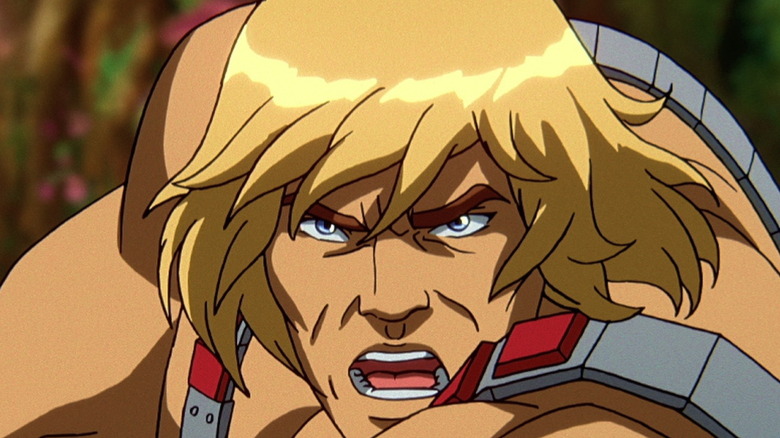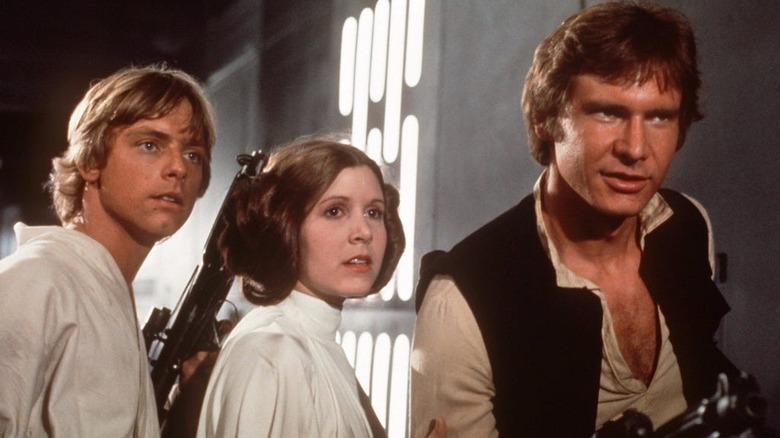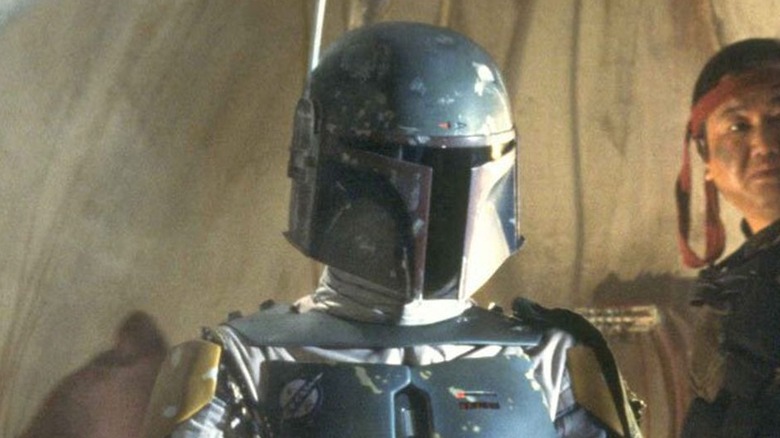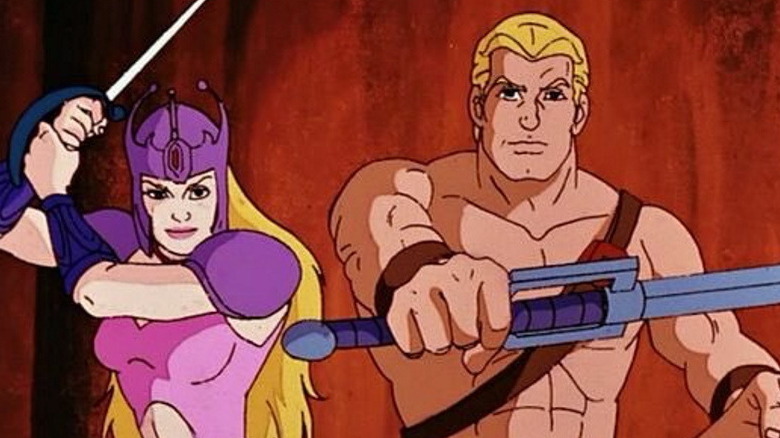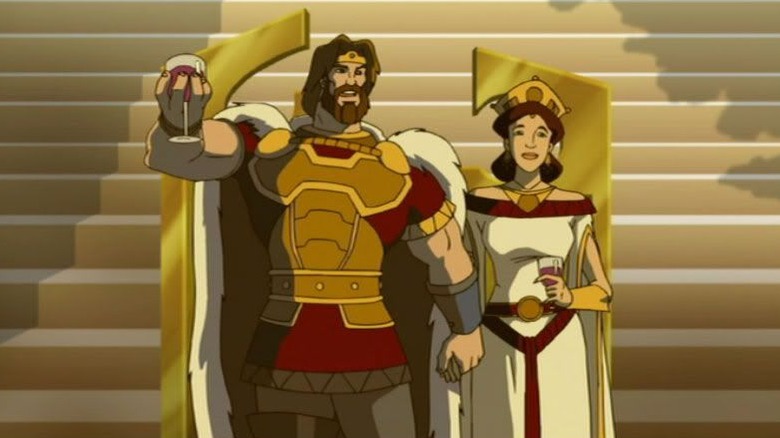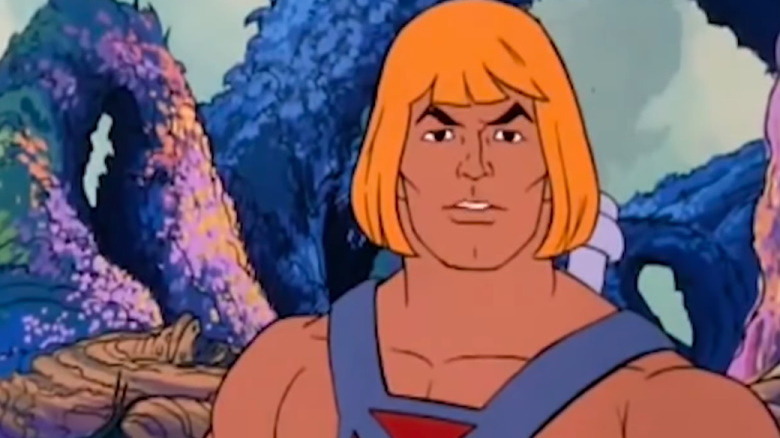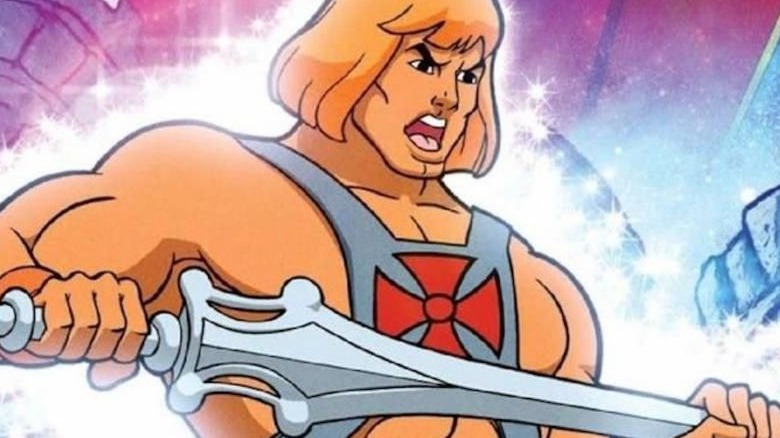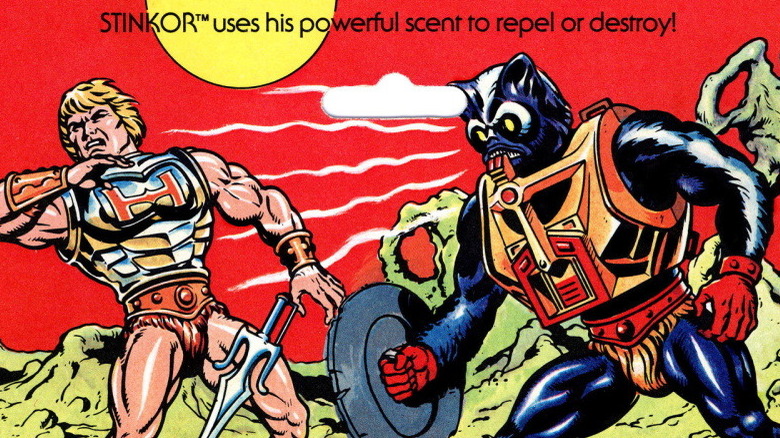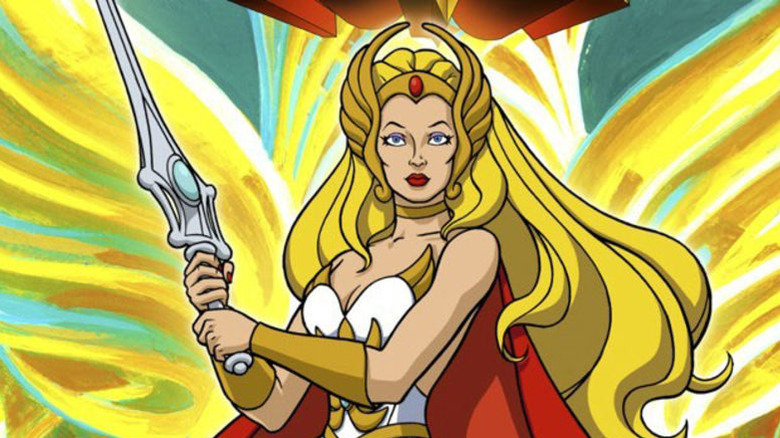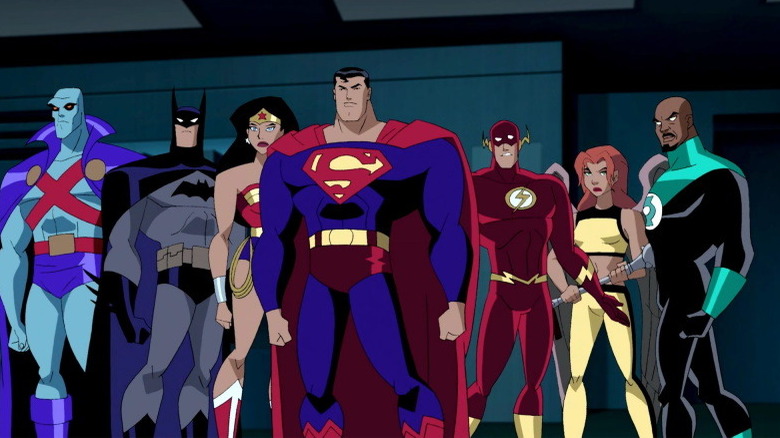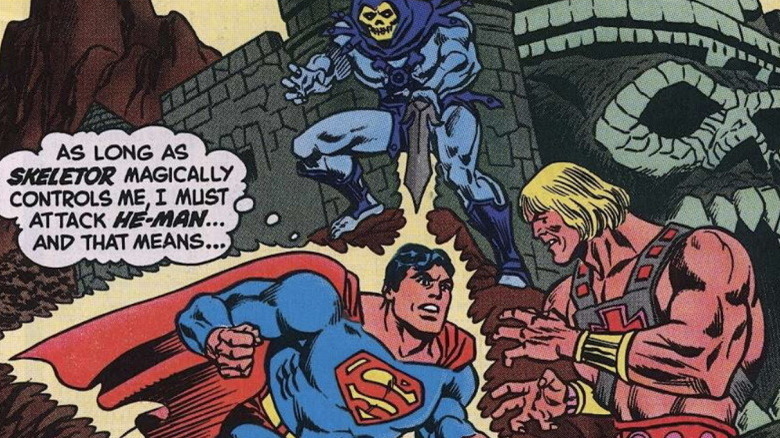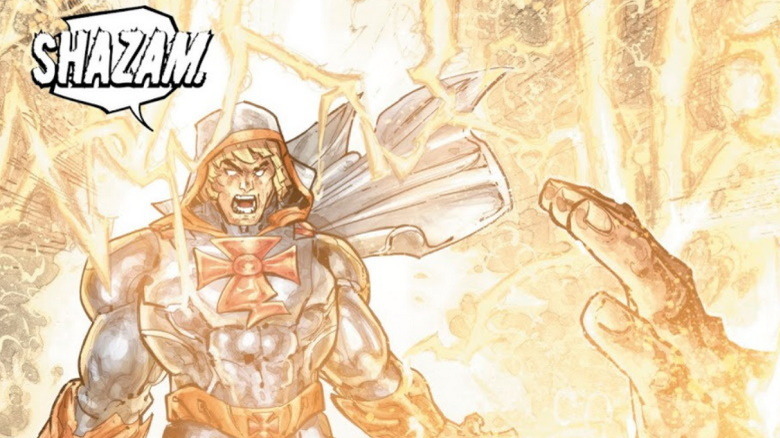The Untold Truth Of He-Man
Every kid who grew up immersed in the American pop culture of the 1980s knows the broad strokes of the "He-Man and the Masters of the Universe" story: Gifted with a magic sword that grants him "fabulous secret powers," humble Prince Adam transforms into the super-strong barbarian He-Man to defend his home planet of Eternia from the evil forces of skull-faced villain Skeletor.
As it turns out, though, this is only a fraction of the real story of the He-Man franchise, which boasts a history that goes well beyond a popular '80s cartoon and extends into a groundbreaking toy line, fan favorite comic book appearances, and multiple animated spin-offs — including the 2021 Kevin Smith-fueled Netflix series "Masters of the Universe: Revelation." With a whole new generation primed to get to know all about He-Man and his ever-expanding story world, here's the untold truth about He-Man and the Masters of the Universe.
He owes his existence to Star Wars
The 1980s saw a major explosion in action figures, largely due to the "Star Wars" film franchise and the popular figurines of characters like Luke Skywalker and Darth Vader manufactured by Kenner Toys. Surprisingly, however, Kenner wasn't the first toy company that received an offer to produce "Star Wars" toys.
In 1976, Ray Wagner, the CEO of Mattel, Inc. declined George Lucas' asking price of $750,000 to produce a toy line of "Star Wars" action figures — a decision he undoubtedly ended up regretting when the toys became one of the most lucrative parts of the film franchise. Needing to play catch-up, Mattel launched several medieval and science fiction-themed toy lines of their own, hoping to create the next hit action figure in the bargain.
According to the book "Mastering the Universe: He-Man and the Rise and Fall of a Billion-Dollar Idea," Roger Sweet, a designer at Mattel, decided to give Mattel's marketing team a generic name — He-Man — to build a toy line around. Although none of the aspects of He-Man's mythology had been developed yet, the simplicity of the name was key — it gave the company's team of designers a mostly blank canvas that they could use to create virtually any story world they imagined.
He could have worn a Mandalorian helmet
Today, it's impossible to separate the name "He-Man" from the image of a massively muscled, blonde barbarian. But when Mattel began developing the He-Man concept, the toy line could have gone in any number of different directions.
At one point, Mattel executives were given a choice between three prototype models of He-Man: a barbarian, a soldier, and a science fiction hero. Weirdly, the sci-fi version of He-Man wore a helmet that looked very much like the Mandalorian helmet worn by Boba Fett (Jeremy Bulloch) in "The Empire Strikes Back" (1980), as well as Jango Fett (Temuera Morrison) and the Mandalorian Din Djarin (Pedro Pascal) in later "Star Wars" films and TV series.
Ultimately, the barbarian version of He-Man proved the most appealing to the executives and the "He-Man and the Masters of the Universe" backstory went on to become a sword-and-sorcery epic (with a few science fiction elements added into it). However, it's strange to think that, at one point, He-Man could have been Mattel's version of a Mandalorian. Lucasfilm likely wouldn't care for the design though, so it's lucky that He-Man decided to bare his distinctive pageboy haircut and tanned face to the world.
He has multiple origins
Seeing how "He-Man and the Masters of the Universe" developed from a toy line into an animated series is interesting because it reveals how He-Man's story world has been regularly reimagined.
Mattel included a mini-comic with its action figures that helped flesh out the characters' backstories. Originally, He-Man was a barbarian from an Eternian tribe that existed in a post-apocalyptic world. Armed with advanced weaponry, He-Man defended Castle Grayskull from his enemy Skeletor. Interestingly, He-Man and Skeletor both possessed half of the original Power Sword (to reflect the way kids could combine the action figure swords into one).
By 1983, Mattel had partnered with Filmation to develop a He-Man cartoon that provided He-Man's most popular origin — now he was Prince Adam of Eternia, who had been endowed with the power to transform into He-Man using the Power Sword provided by The Sorceress of Castle Grayskull. Adam could also turn his cowardly pet Cringer into the fearsome Battle-Cat, and fought with his allies against Skeletor's forces.
Other cartoons continued tweaking He-Man's origin. In "The New Adventures of He-Man," He-Man was summoned to the future to defend mankind, reviving his science fiction roots. In the 2002 "He-Man and the Masters of the Universe" reboot, Adam was a spoiled teen who reluctantly became He-Man to rescue his kingdom from Skeletor. While most animated series keep the most popular beats, there's always room for some revision.
He's a child of two worlds
He-Man may be Eternia's greatest champion, but he has roots in another world — Earth. According to the 1980s cartoon series, Prince Adam's mother Queen Marlena was an astronaut from Earth who crash-landed on Eternia and ended up marrying the planet's King Randor. One episode, "The Rainbow Warrior," referenced Marlena's piloting skills, but she was mostly relegated to being a background player.
In the made-for-TV animated film "He-Man & She-Ra: A Christmas Special" (1985) Grayskull's jester Orko accidentally traveled to Earth during Christmas time and brought back a couple children, causing Queen Marlena to reminisce about the holiday from her planet. Prince Adam actually got to play Santa Claus at one point, showing how Marlena had been influencing Eternia's culture.
Most interestingly, however, it turns out the Earth that Marlena is from exists in the DC Universe, as seen in "DC Comics Presents #47" where He-Man acknowledges Marlena told him stories about Superman, the protector of her home world. She may be a bit player, but her status as an Earth woman offers an interesting wrinkle in He-Man's backstory.
He was voiced by Morris the Cat
Both He-Man and his alter ego Prince Adam were voiced by John Erwin in the 1980s cartoon. A talented voice actor, Erwin gave He-Man a majestic, authoritative voice and delivered Adam's lines with a more laid-back attitude. This helped differentiate the two personas, even although the show's original character designs made the two of them look identical save for He-Man's darker tan.
Beyond He-Man, Erwin has an impressive list of live action and voice acting credits to his name, including roles in "Rawhide," "Back to the Future II" (1989) and "Babe" (1995). However, his most famous role was "Morris the Cat," the feline spokesperson who functioned as the face of 9-Lives cat food in TV commercials during the 1970s.
That's right — the voice of He-Man got famous delivering snarky lines like, "Who says I need improving?" as a fat orange cat who rivaled Garfield in deadpan humor. With this sort of resume, the He-Man cartoon probably missed out on a golden opportunity to also cast Erwin as He-Man's feline steed Battle-Cat (who was voiced by celebrated voice actor Alan Oppenheimer).
He prefers to solve problems non-violently
He-Man may look like a warrior straight out of the sword-and-sorcery epics of Conan the Barbarian, but the 1980s cartoon went out of its way to show him dealing with problems non-violently and in a pacifistic manner. While he was capable of lifting mountains and pushing a moon out of orbit, He-Man rarely used his great strength to hurt people and usually limited his punching targets to robots or buildings. Many episodes showed him using diplomacy to convince potential enemies to change their ways, even getting Daimar the Demon King (Erik Gunden) to reconsider invading Eternia in the episode "Daimar the Demon."
A lot of this is likely due to the producers wanting parents to believe the cartoon would teach their children good values so they could keep watching the show (and buying the toys). Much like "G.I. Joe," the episodes even regularly ended with a moral as Prince Adam, Teela, or the other characters instructed viewers on the importance of telling the truth or working problems out by asking for help.
The cartoon unintentionally showed some Nazi imagery
Superheroes typically wear a symbol or emblem that represents their power — from Superman's "S"-shaped family crest to Batman's bat totem. In He-Man's case, the character designers initially placed an Iron Cross in the center of his chest harness to enhance his distinctive look.
The problem was, while the Iron Cross was a popular military medal used by German armies in the 19th century, it was later appropriated by the Nazi party who placed a swastika symbol in its center. Notably, the swastika itself is an ancient symbol that had been used as a symbol of well-being by many societies before being appropriated by Adolf Hitler for the Nazi flag. As a result, any positive connotations of these symbols have been overshadowed by their repellingly negative use, and they continue to be employed as a hate symbol by extremist groups today.
Naturally, He-Man didn't wear a swastika on his Iron Cross (and being a hero of the planet Eternia, the symbol likely meant something different), but people eventually realized his chest emblem could get people thinking the wrong thing. Because of this, more modern depictions of He-Man have modified the Iron Cross into an "H" symbol.
His smelliest enemy never made it to the classic animated series
Mattel came out with a lot of creative action figures when it developed the original He-Man toy line. Most of the weirdest characters were members of Skeletor's entourage. While many of them, particularly Evil-Lyn and Beast Man, went on to become major figures in the animated series, one action figure was so ridiculous the story editors vowed to never use him in the cartoon.
That would be "Stinkor," a humanoid skunk whose "power" was that he smelled really bad and gave off toxic odors. Mattel manufactured the toy to intentionally smell bad by treating it with the musky-smelling patchouli oil — which quickly earned it a reputation for stinking up toy boxes nationwide. Stinkor's action figure also came with a mini-comic, "The Stench of Evil," where he attacked He-Man with his horrible body odor, but when the character was presented to the Filmation staff, they reportedly burst out laughing and decided to keep him out of their scripts.
Stinkor finally made it to television in the 2002 "He-Man" cartoon reboot, where it was revealed that he was once a thief who became mutated by a chemical accident. Notably, Stinkor isn't nose blind to his stink and must wear an oxygen mask, making his ability one of the worst superpowers to have.
His sister's sword is arguably more powerful than his
While He-Man was marketed toward boys, girls liked the "Masters of the Universe" too, and Mattel decided to capitalize on this by creating He-Man's twin sister Adora, aka "She-Ra." Given her own toy line and animated series, "She-Ra: Princess of Power," She-Ra defended the world of Etheria from the Evil Horde after being given a "Sword of Protection" that imbued her with superhuman strength, speed, durability, and agility.
Although She-Ra was established as He-Man's physical equal, she may have been his superior in at least one respect — her "Sword of Protection" could transform into anything she required. Various episodes of her cartoon showed She-Ra turning the sword into a rope, a shield, a boomerang, a magnet, and even ... an ice maker. That's right — although She-Ra's ice maker shot freezing blasts from her sword instead of making ice cubes like the ice makers in hotels, she could literally use her sword as a refrigeration unit.
Frankly, by the time She-Ra started turning her sword into a parachute, things got a little ridiculous — but considering neither He-Man or She-Ra could use their swords offensively due to broadcast standards, maybe the sword's weird powers made sense.
Major Marvel and DC Comics creators got their start on the He-Man cartoon
While fans may now look fondly back on the original "He-Man" animated series with fondness, many admit the cartoon's plots could get a little silly. However, Filmation managed to get some serious talent working on these episodes — and many of their staff members went on to have major careers in DC and Marvel Comics.
Both Bruce Timm and Paul Dini, the minds behind the DC Animated Universe that included the award-winning "Batman: The Animated Series," "Batman Beyond," and "Justice League Unlimited," got their start on the He-Man cartoon. Timm worked as a background artist and layout designer who also wrote He-Man mini comics. Dini was a script writer for the cartoon and wrote episodes such as "Quest for He-Man," where He-Man was rendered amnesic and banished to a contaminated planet to teach kids about the dangers of pollution.
Likewise, J. Michael Straczknski, who had runs on "The Amazing Spider-Man" and "Fantastic Four" for Marvel Comics, served as the story editor for both "He-Man" and "She-Ra" after writing a spec script for Filmation. It might not be as slick as today's animated series, but for many, "He-Man and the Masters of the Universe" helped pave the modern age of superhero animated shows.
He's fought Superman
He-Man may be "the most powerful man in the universe," but how does he stack up against the other "most powerful hero in the universe," Superman? As it turns out, the comics have addressed this question multiple times.
"DC Comics Presents" #47 saw Superman transported to Eternia by a mystic cloud where he met up with He-Man. Although the two started out as allies, Skeletor was able to take magical control of Superman and pit him against He-Man. While it looked like Superman had the upper hand, he quickly distracted Skeletor in time to shake off his control and break off his attack.
However, Superman and He-Man had a much more brutal fight in the "Injustice vs. Masters of the Universe" miniseries that came out in 2018. Taking place in the Injustice Universe where Superman became the dictator of Earth, the story saw several DC heroes journey to Eternia and recruit He-Man to fight the Man of Steel. While He-Man's mystic power allowed him to pummel Superman, some manipulation by Skeletor caused He-Man to lose his connection to Grayskull's magic, and he reverted back to Prince Adam, leaving him at the mercy of Superman, who considered him less of a threat than Captain Carrot.
He's wielded the Power of Shazam
He-Man gets compared often to Conan the Barbarian, but there's one other superhero he shares a lot in common with — Billy Batson, aka the DC hero known as Shazam/Captain Marvel. Like Billy, Adam is a young man imbued with mystic powers that allow him to become a mighty hero. Superman himself made this connection in the "Injustice vs. Masters of the Universe" miniseries ... and fortunately for Adam, so did a certain Wizard.
During the course of the story, Skeletor managed to steal the Power of Shazam and attempted to use it to conquer Eternia. Instead, he got himself killed and inadvertently passed the power of the gods to Prince Adam, who was summoned before the Wizard as his new champion. By simply shouting "Shazam!" Adam transformed into a white-garbed being with similarities to both Shazam and He-Man. Newly empowered, the Shazam He-Man made short work of the corrupt Injustice Superman.
It was a scene bursting with fanboy energy, although He-Man later went back to his standard look and powers. While this might disappoint some crossover fans, when you're already the most powerful man in the universe, being a super strong barbarian is enough.
